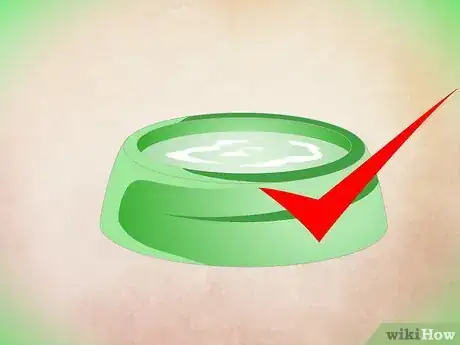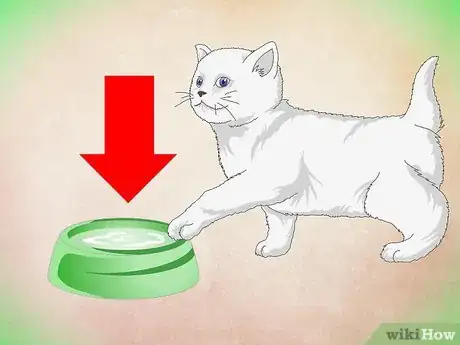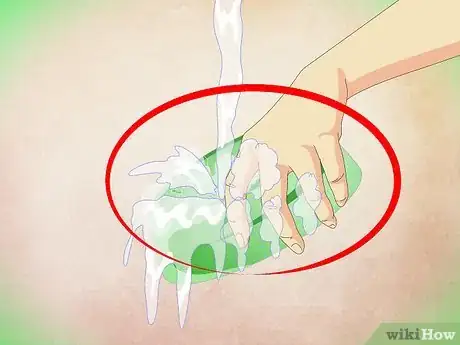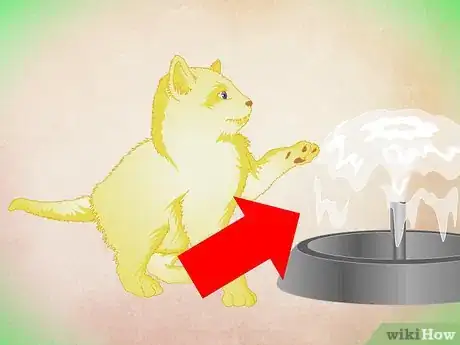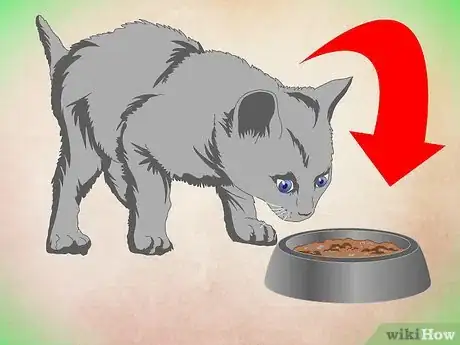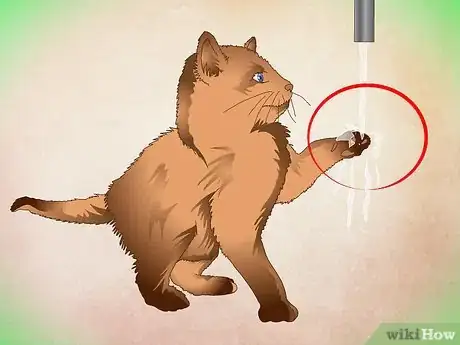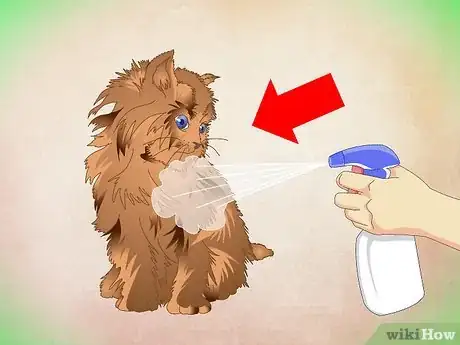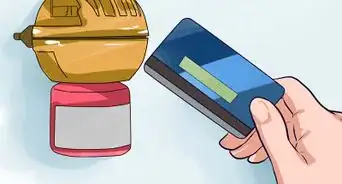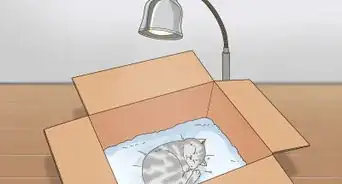This article was co-authored by Natalie Punt, DVM. Dr. Natalie Punt is a Veterinarian and the Founder and CEO of mPet- a smart phone app for pet owners to store, manage and transfer their pets medical records and health information. She specializes in small animal emergency and general medicine and veterinary practice economics. Dr. Punt holds a BS in Biochemistry and Molecular Biology from The University of California, Davis, an MS in Biochemistry from The University at Buffalo, and a DVM from Western University of Health Sciences.
There are 8 references cited in this article, which can be found at the bottom of the page.
This article has been viewed 108,925 times.
Cats and water. Not the best of friends. But, like any animal, cats need water to survive. If you want to make sure your new kitten is getting enough drinking water, you can learn to monitor your cat's hydration habits and ensure that she's getting enough. You can also learn some basic tips on introducing you cat to water, if there's ever a need for a bath.
Steps
Making Sure Kittens are Hydrated
-
1Leave the kitten with its mother until its at least 4-6 weeks old. Kittens learn to eat, clean themselves, and drink water from their mothers as they grow.[1] Kittens need to be left with their mother for at least a month before they start being weaned off of milk and onto solid food. This process usually takes about two weeks.
- If your cat was taken from its mother too early, or was orphaned, you can usually start weaning around three weeks.
-
2Provide fresh drinking water daily. You shouldn't need to do anything to "teach" a cat to drink but provide plenty of fresh drinking water in an accessible location for your cat. Each day, pour out any leftover water in the cat's bowl and refill it to provide for the cat.
- Don't worry if you don't see your cat drinking regularly or your cat doesn't drink just because you put some water in front of it.
- Water can be room temperature. It doesn't need to be cold for the cat to be attracted to it.
- Try mixing an enticing flavor like tuna into the water.[2]
- You can also offer your cat a saucer of bone broth, which may entice him to drink.[3]
Advertisement -
3Make sure the bowl is easily accessible. Experiment some with different sizes and shapes of cat bowls if your cat seems hesitant to eat or drink from them. Stainless steel, ceramic, and glass bowls are all easy to clean and make for fine cat dishes. If your cat has difficulty reaching into the bowl, get a smaller bowl.
- Keep the cat's food and water right next to each other, and introduce them to your cat by sitting and petting the cat while you pour food and water into the bowl. The cat shouldn't have to go looking for something.
- The cat's food and water should be in a separate place from its litter. Just like people, cats don't like to eat and do their business in the same place.[4]
-
4Clean the cat's water bowl. Your cat's water bowl can get gummed up with saliva and minerals from tap water, and it needs to be rinsed out thoroughly every couple of days. Rinse the bowl with warm soapy water and a dish sponge, then rinse it thoroughly before refilling it.
- No, you don't need to scour cat bowls like you might your fine china, but it's a good idea at least to rinse it out every couple of days. It only takes a minute and your cat will appreciate drinking from a clean bowl.
-
5Try drinking water fountains. Available at most pet stores, water fountains are sometimes sold for cats who are hesitant to drink water.[5] They work like regular water fountains, which cycle water continuously in a little pond that burbles up for the cat to drink. Some cats go crazy for these products.
- Typically, these range anywhere from $20-30 and are usually operated by plugging into an outlet. Most cats shouldn't need these, but it's a good way to pamper, if you want to give your cat a little extra.
-
6Feed cats canned wet food. Some research shows that cats who are fed exclusively dry food are somewhat dehydrated, and sometimes suffer from urinary health issues.[6] Feeding cats food with a higher water content is usually a good idea. If you can, try to feed your cat canned "wet" food a few times a week.
- You can even mix some water into your cat's wet food to make it a little more soupy.[7]
- Wet cans of food are typically more expensive, making it difficult to feed a cat exclusively cans of Fancy Feast. Instead, try buying a few big cans and mixing a few spoonfuls into the cat's dry food every day, to make sure your pet's getting the water content it needs.
- You can also add some water to the cat's dry food. When you add some dry food to the cat's bowl, add some water to the dish, mixing it in to make sure the cat gets the water it needs. Giving them about two tablespoons of water should be enough.
- You can also mix some bone broth into your cat's dry food.[8]
Making Kittens Comfortable Around Water
-
1Get a breed that enjoys being around water. Most cats won't like to be anywhere near water, but some breeds are more accommodating than others.[9] If you'd like your cat to be water-friendly, consider getting any of the following common cat breeds:
- Bengal
- Turkish angora or van
- American bobtail
- Maine coon
-
2Introduce the cat to water early. Kittens are more likely to be calm around water the earlier you introduce them to it. Within the first few months of the cat's life, it's ok to try to introduce them to water calmly and gently, going a little at a time.
- Introduce the cat to water when its calm and tired. The best time to bathe a cat? Right after its been playing, or has eaten. Cats tend to get really active just before eating, and just after is the perfect time to try to introduce your kitten to water, if necessary.
- Trim the cat's claws before you try to introduce it to water, and wear long sleeves when you're trying to play with the cat in water.
-
3Start with a gentle drip. Many house cats are fascinated by dripping faucets. For a quick test, to see whether or not your cat will be water-friendly or easy to bathe, try to set your faucet to drip at a slow, even rate. Set your cat up on the counter and see if it seems interested in the dripping.
- Some cats will play with faucet water, or even drink from it. Others will ignore it completely. Both are perfectly normal cat responses.[10]
-
4Be gentle. Make sure to be quiet, slow and gentle and use warm water in a spray bottle. Use a calm tone of voice and hold the cat against your body with one hand firmly under its belly. Pet the cat along the back of the neck and the jaw to help it calm down some if you're trying to introduce it to water. Move extremely slowly.
- In some cases, it's good to wrap the cat in a soft, fluffy, warm towel while you're doing this. You can use it to dry the cat off when you're finished, and use it to calm the cat now.
- Never try to introduce a cat to water by submerging it in the tub. There's no reason to use that much water to clean a small cat, and you'll only serve to aggravate the animal.
-
5Dampen a soft washcloth and wipe the kitten's paws. The best way for a cat to contact water is with its paws. Use a small spray bottle to wet a small washcloth with warm water and get the kittens paws wet. Wait a while and let the cat feel the sensation. Let the kitten groom itself and get used to the sensation of the water on its fur.
-
6Add more water as necessary. Eventually, you can apply more water with a spray bottle, or in some cases (with very accommodating cats) bathe them. Go very slowly, gently adding a small amount of water to the cat's fur at a time. Hold the cat firmly against your chest to keep them calm and restrained.
- If you just want to see if your cat will play in water, let your cat dictate the move. If it screeches and struggles to get away from you when you put some water on its paws, guess what? Your cat doesn't like water.
- If the cat makes a break for it, it's usually best to just give it up. Don't force interactions if the cat's not having it.
-
7Dry the cat immediately. Always make sure the kitten is kept warm and immediately dry the kitten off with a towel followed by a warm, fluffy towel. You might be able to use a quiet blow-dryer on a very low setting, unless your cat gets scared off.
- Let the cat groom itself and provide a warm sleeping area for the animal. Again, healthy cats are fully capable of grooming themselves.
-
8Don't force the cat to interact with water. Most cats don't like water and most cats don't need to be bathed. There's little reason to force a cat to do something it doesn't want to do. If your cat doesn't like water, don't force it.
- Cats generally not need to be bathed, and should only be bathed if they've gotten into something especially dirty or toxic.[11] If you must wash your cat, trim their claws first and introduce them to water when they're tired out from playing.
- Don't submerge cats in water to bathe them. Instead, use a spray bottle to wet their fur and gently wash them with a washcloth.
- Dry the cat thoroughly any time they become wet. Use a fluffy warm towel to dry the cat's fur.
Community Q&A
-
QuestionOur female kitten has begun to urinate on our bedspread; she is 5 months old. No UTI. The vet says her urine is concentrated and she needs to drink more water. Plenty is available; how do I encourage her?
 Community AnswerSwitch to a wet food diet. Try placing bowls of water through the house, typically where the cat likes to be. Refill water bowls regularly. If she still won't drink, try flavoring the water with a little juice from can of tuna or low sodium chicken broth.
Community AnswerSwitch to a wet food diet. Try placing bowls of water through the house, typically where the cat likes to be. Refill water bowls regularly. If she still won't drink, try flavoring the water with a little juice from can of tuna or low sodium chicken broth.
Warnings
- Never force your cat to play with water. Most cats will be unwilling, and it's cruel to expect otherwise.⧼thumbs_response⧽
References
- ↑ https://www.aspca.org/pet-care/cat-care/weaning
- ↑ Natalie Punt, DVM. Veterinarian. Expert Interview. 14 September 2021.
- ↑ Rita Reimers. Cat Behaviorist. Expert Interview. 22 June 2021.
- ↑ http://pets.webmd.com/cats/guide/mistakes-people-make-feeding-cats
- ↑ Rita Reimers. Cat Behaviorist. Expert Interview. 22 June 2021.
- ↑ http://www.catinfo.org/?link=urinarytracthealth
- ↑ Rita Reimers. Cat Behaviorist. Expert Interview. 22 June 2021.
- ↑ Rita Reimers. Cat Behaviorist. Expert Interview. 22 June 2021.
- ↑ http://www.vetstreet.com/cats/6-cat-breeds-that-love-to-play-with-water
About This Article
To make a kitten like water, try to introduce it to water as early as possible, like during the first few months of its life, since kittens are more likely to enjoy water if they get used to it early on. At first, try setting your kitten next to a sink and turning the faucet on so it's slowly dripping. If it doesn't seem to mind that, try lightly misting your kitten with some warm water in a spray bottle. You can also wipe your kitten's paws with a damp washcloth to get it used to being wet. For tips on how to keep your kitten hydrated if it doesn't like water, read on!

